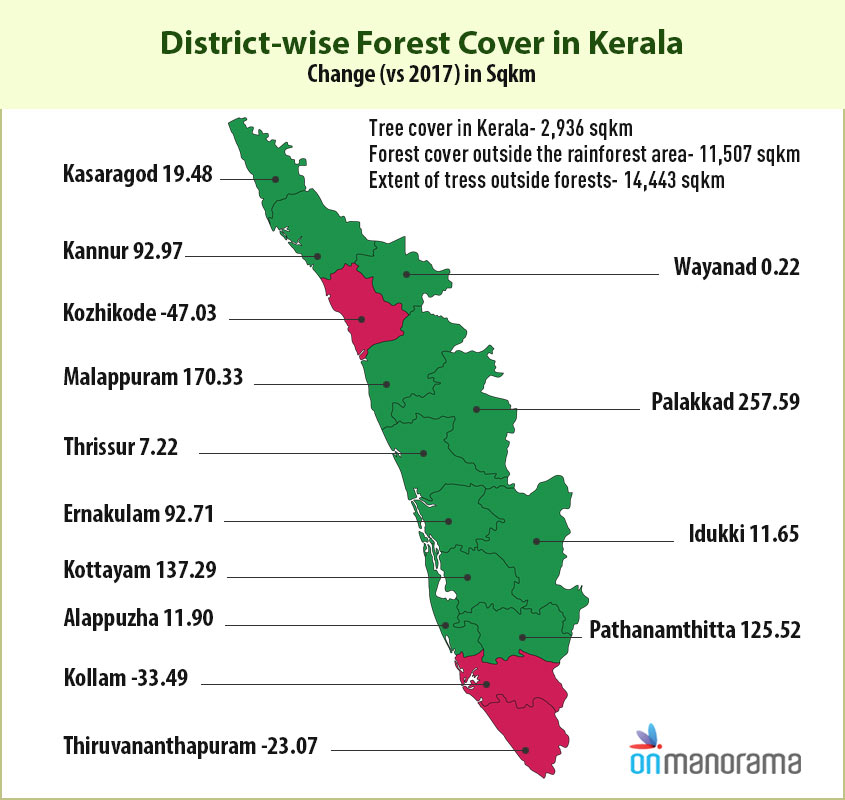India's forest, tree cover up by 5,188 sq. km: Report

Mail This Article
New Delhi: The forest-and-tree cover in India has risen by 5,188 square kilometres in the last two years, said the India State of Forest Report (ISFR) 2019, which showed Karnataka growing the maximum cover of 1,025 sq km.
The biennial report by the Forest Survey of India (FSI), which is an assessment of the country's forest resources, was released by Union Environment Minister Prakash Javadekar on Monday, who revealed that the total tree-and-forest cover in the country includes an increase of 3,976 sq. km (0.56 per cent) of forest cover and 1,212 sq. km (1.29 per cent) of tree cover, compared to the 2017 report.
According to the report, the top three states in terms of forest cover are Karnataka, Andhra Pradesh and Kerala.
While Karnataka grew the maximum forest-and-tree cover at 1,025 sq km, Andhra Pradesh grew a 990-sq. km cover and a 823-sq. km of forest cover was created by Kerala in the last two years.
Two other states that followed are Jammu and Kashmir, which grew a 371-sq. km forest cover, and Himachal Pradesh, where a 334-sq. km forest area was created.
"Forest cover in the hill districts of the country is 2,84,006 sq. km, which is 40.30 per cent of the total geographical area of these districts. The current assessment shows an increase of 544 sq. km (0.19 per cent) in 140 hill districts of the country," the report said.
It specified that the forest data of Jammu and Kashmir, recorded through satellite imaging, "covers areas outside LoC that is under the illegal occupation of Pakistan and China".
However, the north-east did not show positive results as the current assessment showed a decrease of forest cover to the extent of 765 sq. km (0.45 per cent) in the region.
"Except Assam and Tripura, all states in the region show a decrease in the forest cover," Javadekar said, while reading out the salient findings of the report.
According to the report, the total forest cover of India is 7,12,249 sq. km, which is 21.67 per cent of the geographical area of the country.
The tree cover of the country is estimated at 95,027 sq. km, which is 2.89 per cent of the geographical area.
"The total forest-and-tree cover of the country is 8,07,276 sq. km, which is 24.56 per cent of the geographical area of the country," it said.
The report also showed that the mangrove cover in the country had increased by 54 sq. km (1.10 per cent), as compared to the previous assessment.
The minister said after seeing the report, he was confident that India was on track to achieve its climate goal of creating an additional carbon sink of 2.5-3 billion tonnes under the Paris Agreement.
Javadekar said there was an increase of 42.6 million tonnes in the country's carbon stock as compared to the last assessment of 2017.
"This report gives us confidence that we are on track to achieve our Paris Agreement goals," he said.
According to the present assessment, the total carbon stock in India's forests is estimated at 7,124.6 million tonnes.
"There is an increase of 42.6 million tonnes in the carbon stock of the country as compared to the last assessment of 2017. The annual increase is 21.3 million tonnes, which is equivalent to 78.1 million tonnes of CO2.
"Soil Organic Carbon (SOC) represents the largest pool of carbon stock in forests, which has been estimated at 4,004 million tonnes. The SOC contributes 56 per cent to the total forest carbon stock of the country," the report said.
It also said 21.4 per cent forest cover in the country was susceptible to fire.
"Fire prone forest areas of different severity classes have been mapped in the grids of 5km x 5km, based on the frequency of forest fires. The analysis reveals that 21.40 per cent of the forest cover of the country is highly to extremely fire prone," it said.
Dependence of fuelwood on forests was the highest in Maharashtra, whereas, for fodder, small timber and bamboo, the dependence was highest in Madhya Pradesh.
The report has assessed that the annual removal of small timber by the people living in forest fringe villages is nearly seven per cent of the average annual yield of the forests in the country.
The event was attended by Environment Secretary C K Mishra, Siddhant Das, Director General-Forests, Ministry of Environment, Subhash Ashutosh, Director General, FSI, and other officials from the ministry as well as states.
Lauding the efforts of the FSI, Mishra said it was not a routine work but added value and new content to the report.
"It is not a routine mathematical report. It adds value to the report and new content. It provides a set of data which is like a mirror for us to guide us in the right direction. This report is used for policy formulation and improving the quality of forests too," he said.
Elaborating on the techniques behind the report, Das said it was the outcome of remote sensing and field observation for two years.
"It is the 16th report in the series, which gives out data of not just forests but of mangrove, forest carbon, bamboo resources and forest fires.
"The report was made in collaboration with several institutions, which helped ensure high technological standards. The report is richer in content than the previous one with two volumes -- one on the national-level assessment and the other state-specific," he said, adding there were 40 analysts behind it.
The report said there was an increase of 3,229 sq. km of bamboo-bearing area in the last two years, with the total bamboo-bearing area of the country estimated at 1.60 lakh sq. km.


